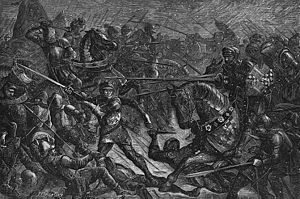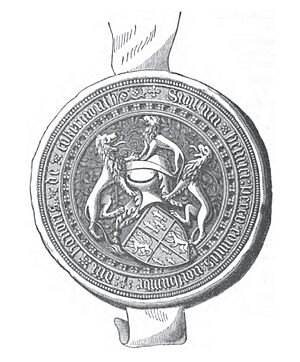Henry Percy, 3rd Earl of Northumberland facts for kids
Quick facts for kids
Henry Percy
|
|
|---|---|
| 3rd Earl of Northumberland | |

Arms of Percy (modern), as seen on seal of Henry Percy: Or, a lion rampant azure (1&4); Gules, three lucies hauriant argent (2&3)
|
|
| Born | 25 July 1421 Leconfield, Yorkshire, England |
| Died | 29 March 1461 (aged 39) Battle of Towton, Yorkshire |
| Buried | St Denys's Church, York |
| Family | Percy |
| Spouse | Eleanor Poynings (m. 1435) |
| Issue Detail |
|
| Father | Henry Percy, 2nd Earl of Northumberland |
| Mother | Lady Eleanor Neville |
Henry Percy, 3rd Earl of Northumberland (born July 25, 1421 – died March 29, 1461), was an important English noble. He lived during a time of great change and conflict in England.
The Earldom of Northumberland was a very important and large area of land in northern England. Henry Percy also became Lord Poynings when he married. This title led to some disagreements with the Poynings family. He also had many disputes with other powerful families during his younger years.
Henry Percy married Eleanor Poynings, and they had four children. He was a strong supporter of the Lancastrian side during the Wars of the Roses. He gained a lot of power and land during this war, even though his father died early in the fighting. Sadly, Henry Percy did not get to enjoy his gains for long. He was killed at the Battle of Towton in 1461, fighting for the losing Lancastrian side.
Early Life and Border Wars
Henry Percy was the son of Henry Percy, 2nd Earl of Northumberland. His mother was Lady Eleanor Neville. She was the daughter of Ralph Neville, 1st Earl of Westmorland.
Henry Percy became a knight in 1426, alongside King Henry VI. On April 1, 1440, he was put in charge of the eastern border with Scotland. This important job was called the Warden of the Eastern March. He was also responsible for defending Berwick Castle. He held this position until March 1461.
In May 1448, Henry Percy, his father, and Sir Robert Ogle attacked Scotland. They burned towns like Dunbar and Dumfries. In return, the Scots attacked his father's castles, Alnwick and Warkworth. King Henry VI traveled north and sent Percy to raid Dumfrieshire. This attack failed, and Percy was captured in a swamp. This happened after his father's army was defeated at the Battle of Sark. Sir Robert Ogle was then declared an outlaw. The king used half of Ogle's lands to pay back Percy for the money he spent to get released from captivity.
Problems with Scotland continued. Henry Percy and other nobles were asked to stay and guard the border instead of attending Parliament. In 1451, a peace agreement with Scotland was being discussed. Percy was asked to meet with Scottish representatives. In July 1455, he successfully stopped an attack on Berwick by the Scottish King, James II. The English King congratulated him for this success.
Family Disputes
In the late 1440s, the people who rented land from Henry Percy's father in Yorkshire often fought with their neighbors. These neighbors rented land from the Archbishop of York. Percy's brothers led these armed fights. These events were so serious that King Henry VI had to travel north in 1448.
In the same year, the Earl of Northumberland's followers kicked out a relative, Robert Poynings, from his lands in Sussex. This was due to an argument about family inheritance. A year later, Henry Percy, now Lord Poynings through his wife, joined his father in attacking Robert's land in Kent. This attack involved stealing cattle and other things. Robert later said the attack was so brutal that he was afraid to seek justice for three years.
By the early 1450s, relations with another powerful family, the Nevilles, became very tense. Percy's brother, Thomas, Lord Egremont, ambushed a Neville group returning from a wedding. He had between 1,000 and 5,000 men. Although no one was hurt in this specific event, there had been violence in the area before. By October 1453, Henry Percy was directly involved. He, his father, and his brothers, along with Lord Clifford, forced a battle with John and Richard Neville at Topcliffe.
The dispute continued into the next year. Percy reportedly planned to attend Parliament with a large group of men in February. Three months later, the king asked both him and his father to attend a meeting to make peace. Neither of them, nor John Neville or Salisbury, followed the king's request.
Wars of the Roses

During the Wars of the Roses, Henry Percy followed his father in supporting the Lancastrians. They fought against the Yorkists. His father died at the First Battle of St Albans on May 22, 1455. This battle is often seen as the first major fight of the wars.
Henry Percy then became the 3rd Earl of Northumberland. He did not have to pay a special fee to the Crown because his father died serving the King. He promised to support the Lancastrian royal family. In October 1458, an attempt was made to bring peace between the powerful nobles in London. However, Henry Percy arrived with so many men (about 1,500) that the city would not let him in. He and his brother Egremont had to promise to keep the peace.
When fighting started again, he attended a special Parliament in October 1459. This Parliament declared the Yorkists to be traitors. They were accused of causing his father's death four years earlier. On December 30, 1460, Percy led the main part of the Lancastrian army at the Battle of Wakefield. The Lancastrians won this battle. After the victory, the army marched south towards London, taking goods from towns along the way.
He fought against Warwick at the second Battle of St. Albans on February 17, 1461. He also led the front line of the Lancastrian army at the Battle of Towton on March 29, 1461. However, his archers were blinded by snowstorms. He was either killed in close combat or died from his injuries soon after. He was buried at St Denys's Church, York. After his death, the new King, Edward IV, declared him a traitor in November 1461. Henry Percy's son, also named Henry, was sent to the Tower of London.
Estates and Finances
The lands of the Earls of Northumberland were very important for providing soldiers and money to defend the border with Scotland. Henry Percy, as the Earl, received a large salary for his role. He got £2,500 each year during peacetime and £5,000 during war. He also received money to maintain Berwick Castle.
However, it was often hard to get these payments from the government. For example, in 1454, he received no payments at all. Sometimes, he had to use his own money to cover costs. The Crown tried to pay him on time because he was a loyal Lancastrian. He even received full wartime pay for all of 1456-1457.
After the Lancastrians won at Ludford Bridge, Henry Percy was given more important jobs. He became the Chief Forester north of the River Trent and the Constable of Scarborough Castle in December 1459. He was also given control of lands in Yorkshire, Derbyshire, and Cambridgeshire that belonged to Salisbury, a Yorkist.
After the Yorkists captured King Henry VI in 1460, they accused Percy of stealing from York's northern lands. This was likely true, as his continued taking of goods from these lands led York to march north to Wakefield in December 1460. These incomes were very important for Percy, both personally and for his military needs. His northern lands had faced financial difficulties for much of the 1400s. Even when the earldom was taken by the Crown in 1461, he still owed about £12,000.
Family
Around June 25, 1435, Henry Percy married Eleanor Poynings (born around 1422 – died February 11, 1484). This marriage was arranged by his father and Cardinal Beaufort. Eleanor was the daughter and heir of Sir Richard Poynings. In 1446, she inherited the title of Baroness Poynings and large estates in southern England.
Henry Percy was called to Parliament from 1446 to 1455 as "Henry de Percy, Knight, Lord of Poynings." His wife, Eleanor, was mentioned in her mother's will in 1455. Henry and Eleanor had at least one son and four daughters:
- Anne Percy (1444–1522), who married Sir Thomas Hungerford in 1460.
- Margaret Percy (born around 1447), who married Sir William Gascoigne.
- Henry Percy, 4th Earl of Northumberland (born around 1449 – died April 28, 1489), who married Maud Herbert.
- Eleanor Percy (1455-around 1477), who married Thomas West, 8th Baron De La Warr. They had no children.
- Elizabeth Percy (1460–1512), who married Henry Scrope, 6th Baron Scrope of Bolton.





